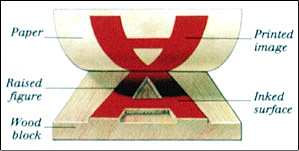In this technique, the
artist draws imagery on
the desired matrix and
then cuts away pieces
from the surface, leaving
only the imagery raised.
Then, ink is applied on
to the surface with a
roller and the image is
transferred to the paper
with a press or by hand
burnishing or rubbing.
Since the recessed, cut
away areas do not receive
ink, they appear white
on the printed image.
A relief print typically
has bold dark-ligh contrasts
and an impression into
the paper of the inked
lines. The various relief-printing
techniques are…

Wood cut
Woodcut is the earliest
and most enduring, in
that it is still practiced,
of all print techniques.
While woodcuts were first
seen in ninth-century
China, Western artists
have made woodcut prints
since the fourteenth century.
They were originally conceived
as religious icons and
sold as souvenirs or a
pilgrimage to some holy
site. Woodcut soon became
a popular medium for the
mass distribution of religious
and instructive imagery
in Europe, not least through
books since, with the
invention of moveable
type, the woodblocks matrix
could be set in the same
press with the text and
both text and image printed
together. In the seventeenth
and eighteenth centuries,
woodcuts were developed
in Japan to an exceptional
level of artistic achievement,
what is known as the ukiyo-e
period or style.
Wood Engravings
Wood Engravings are made
from the end-grain surface
of very hard wood, usually
boxwood, as opposed to
woodcuts, which are made
from side-grain planks
of wood neither so hard
nor so expensive. Rather
than cutting away non-printing
areas with a knife, wood
engravings are made with
fine engraving tools,
which, however, engrave
the non-printing areas.
As in woodcuts, it is
the surface that takes
the ink and prints. Incredible
precision and detail is
possible in this technique.
Chiaroscuro Woodcuts
Chiaroscuro Woodcuts involve
the use of several blocks,
often one for each colour
to be used and sometimes
one to outline the composition
of the image. Printing
a sheet of paper, with
each of the blocks, in
turn, using some method
of registration, to avoid
misplacement or overlapping
makes the print. Where
a non-Printing area has
been cut out of all the
blocks, the natural white
of the paper shows through
in the finished print,
giving the reason for
the name Chiaroscuro (Light-Dark).
Usually no more than three
or four blocks are used
and the purpose of the
technique is to imitate
the appearance of a wash
drawing, not to attempt
to capture reality.
Colour Woodcuts
Colour Woodcuts, in the
West a product of the
nineteenth century, use
the same technique as
chiaroscuros, but often
carried to an enormous
complexity of multiple
blocks and over-lapping,
and they commonly employ
more realistic colours.
The greater the complexity,
the greater the rates
of failed or imperfect
impressions, so impressions
of many colour woodcuts
are both rare and Expensive.
In Japan the colour woodcut
had much earlier become
the dominant print technique
and the complexities and
subtleties of the greatest
masterpieces have probably
never been equalled elsewhere.
White Line Woodcut
White Line Woodcut, This
is a technique developed
in America that allows
a colour woodcut print
to be produced from a
single block. The outline
of the design is cut away
(so that it will not print)
and the desired colours
are painted on the block,
always separated by the
cut-away outline. When
printed, the image shows
a white line delimiting
each area of colour.
Linocuts
Linocuts are printed from
a linoleum block, usually
backed with wood for reinforcement.
The linoleum is handled
in exactly the same way
as a wood block but, since
it does not have a wood
grain, the surface of
the resulting print will
have less texture. Colour
linocuts are produced
by the same method as
colour woodcuts. The material
takes all types of lines
but is most suited to
large designs with contrasting
tints.